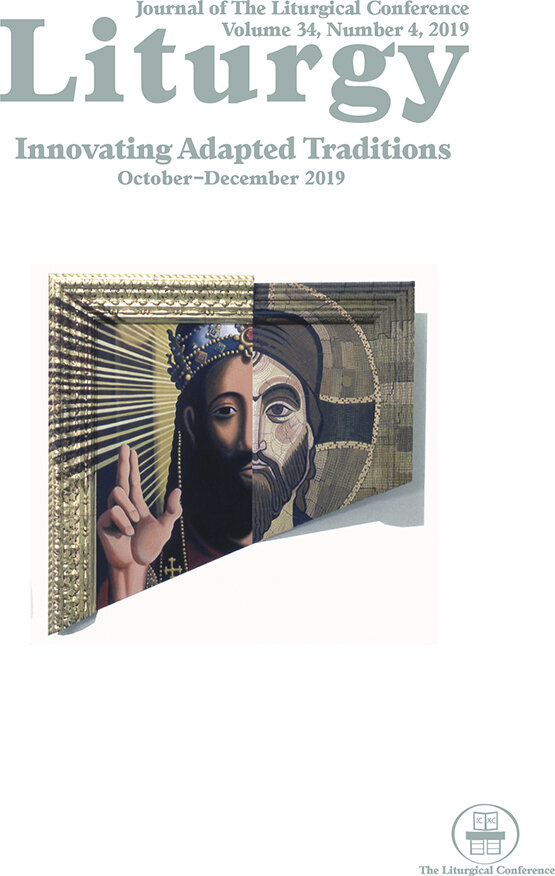Liturgy 34.4: Innovating Adapted Traditions
This issue of Liturgy dealing with “Innovating Adapted Traditions” explores the many ways worship leaders are creatively addressing contemporary needs.
What follows is an excerpt from Guest Editor Nicholas Zork’s “Introduction” to the issue. I hope this will help define the theme and encourage you to want to read the entire issue. –– Melinda Quivik
~~~~~
Liturgical innovation, like all creative practice, doesn’t happen ex nihilo. Even what Ronald L. Grimes calls “emerging ritual”—ritualization without an inherited script or clear antecedents (Proceedings of the North American Academy of Liturgy, 1990, pp. 15-31)—draws on shared embodied knowledge and inherited ritual vocabulary. Catherine Bell defines “ritualization” as action “performed in culturally relevant ways to generate the perception that these activities are both intrinsically different from other acts and privileged in their significance and ramifications.” (Ritual Theory, Oxford Univ., 1992, pl 219) And although such ritualization––liturgical and otherwise––need not be formal or fixed, unprecedented innovations still modulate—or adapt—what is known in order to explore what is not known. In Meeting Mystery, Nathan Mitchell contends that “Liturgy’s goal isn’t meaning but meeting”—it is “action that draws us into the dynamic, hospitable, yet perilous space of God’s own life.” (Meeting Mystery, Orbis, 2006, p. 59) But we meet this mystery in the numinous, enacted refractions of the familiar.
. . . Liturgical practices rooted in tradition can be appropriated as relevant resources when they are adapted in response to emerging settings. These settings are often very different from those in which the adapted practices have been cultivated. But creating space for mutually formative interactions between liturgical practice and the broader emerging environment can enliven liturgical traditions and settings alike, and the people who—respectively—embody and inhabit them.
This collection of essays will consider a few ways liturgists are innovating adapted traditions. Each author explores what I would call liturgical ecologies. This concept of a liturgical ecology is adapted from Tia DeNora’s “aesthetic ecology,” which she defines as “a cluster of people and their relations to and with each other, as well as materials and settings, situated vocabularies, symbols, values, patterned ways of doing and—importantly—happenstance.” (Music-in-Action, Ashgate, 2011, p. xi) An ecological paradigm for innovative liturgical adaptation reminds us that the efficacy of liturgical or quasi-liturgical action springs from the dynamic, interdependent, interplay of entwined aspects of a liturgical ecology: social, personal, environmental, cultural, historical, architectural, theological, and more.
Liturgical adaptation is often approached as a matter of translating a liturgical text—literally or metaphorically—for a new context. Two challenges attend this paradigm.
First, the text-context binary renders liturgical practice overly semantic in its ostensible import—a text to be interpreted for meaning rather than understood as a resource for doing (including meeting). Second, such a reductive approach often fails to appreciate how radically the meaning and doing can change in response to new, living settings. The adapted traditions reresented in the essays. . . are, in part, inspiringly innovative because they are not merely adapted to fit a setting; their emerging liturgical ecologies profoundly transform them. Whether the adapted tradition is a simple rite, a full liturgy, or a quasi-liturgical practice like singing together, the creative process of efficacious liturgical adaptation is not linear: practices are not simply altered to fit a fixed setting; the dynamic setting is itself a formative resource that shapes practice.
The full essay in Liturgy 34, no. 4 is available online by personal subscription and through many libraries.
Nicholas Zork, “Innovating Adapted Traditions: Introduction,” Liturgy 34, no. 4 (2019): 1-3.
